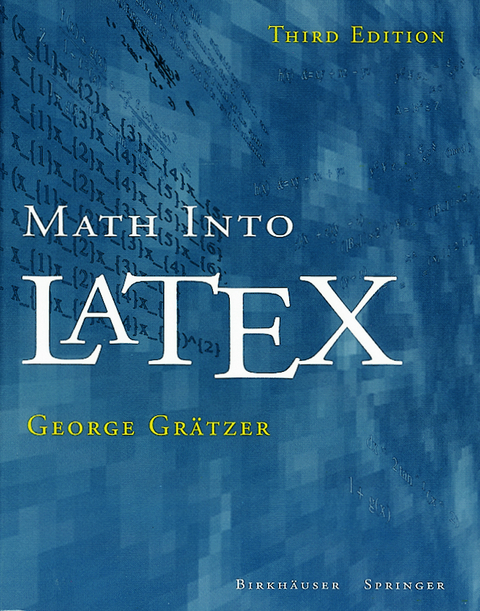
Math into LaTeX
Birkhauser Boston Inc (Verlag)
978-0-8176-4131-3 (ISBN)
AMS packages that replaced AMS-Ib-TEX, version 1.1, but the book still had an AMS-Ib-TEX-centric view. This third edition is about Ib-TEX. Where necessary, I recommend that you use packages to extend Ib-TEX's capabilities. For typesetting mathematics, I strongly recommend that you use the AMS packages. AMS packages, version 2.0 The American Mathematical Society released version 2.0 ofthe AMS packages in 1999. This third edition covers the changes made in this release. Books The first and second editions of this book dealt primarily with the tasks involved in writing artides. In Part V, the third edition addresses the issues that arise when creating longer documents. In addition to chapters on BIBTEX and Makelndex, I have added a new chapter on writing books. Appendix F illustrates the impor tance of choosing a well-designed book document dass. Other changes B/1EX Ib-TEX2 has been remarkably stable since its release in 1996, becorning c the standard Ib-TEX (see Section C.1.2). Changeshave been rninor except for ad vances in using Ib-TEX with non-English languages (see the new Appendix E) and the widespread use of the PostScript CM and AMS fonts (see the new Section D.l). Reorganization and additions Due to the new emphasis on writing books, a number of sections and subsections have moved from Chapter 2 and Chapters 6-8 to the new Chapter 12.
I A short course.- 1 Typing your first article.- II Text and math.- 2 Typing text.- 3 Text environments.- 4 Typing math.- 5 Multiline math displays.- III Document structure.- 6 LATEX documents.- 7 Standard LATEX document classes.- 8 AMS documents.- IV Customization.- 9 Customizing LATEX.- V Long documents.- 10 BIBTEX.- 11 Makelndex.- 12 Books in LATEX.- VI Math and the Web.- 13 TEX, LATEX, and the Internet.- 14 Putting LATEX on the Web.- A Math symbol tables.- A.1 Hebrew and Greek letters.- A.1.1 Hebrew letters.- A.1.2 Greek letters.- A.2 Binary relations.- A.2.3 Negated binary relations.- A.3 Binary operations.- A.4 Arrows.- A.5 Miscellaneous symbols.- A.6 Delimiters.- A.7 Operators.- A.7.1 “Pure” operators, with no limits.- A.7.2 Operators with limits.- A.7.3 Large operators.- A.8 Math accents and fonts.- A.8.1 Math accents.- A.8.2 Math fonts.- A.9 Math spacing commands.- B Text symbol tables.- B.1 Some European characters.- B.2 Text accents.- B.3 Text font commands.- B.3.1 Text fontfamily commands.- B.4 Additional text symbols.- B.5 Additional text symbols with T1 encoding.- B.5.1 Accents.- B.5.2 European characters.- B.5.3 Quotation marks.- B.6 Text spacing commands.- C Background.- C.1 A short history.- C.1.2 Recent developments.- C.2.1 The layers.- C.2.2 Typesetting.- C.2.3 Viewing and printing.- D PostScript fonts.- D.2 The Times font and MathTime.- D.3 Lucida Bright fonts.- D.4 More PostScript fonts.- F A book document class.- G Conversions.- H Final word.- H. 1 What was left out?.- H.2 Further reading.
| Zusatzinfo | 12 Illustrations, black and white; XXXVIII, 584 p. 12 illus. |
|---|---|
| Verlagsort | Secaucus |
| Sprache | englisch |
| Maße | 191 x 235 mm |
| Themenwelt | Informatik ► Theorie / Studium ► Künstliche Intelligenz / Robotik |
| ISBN-10 | 0-8176-4131-9 / 0817641319 |
| ISBN-13 | 978-0-8176-4131-3 / 9780817641313 |
| Zustand | Neuware |
| Informationen gemäß Produktsicherheitsverordnung (GPSR) | |
| Haben Sie eine Frage zum Produkt? |
aus dem Bereich


